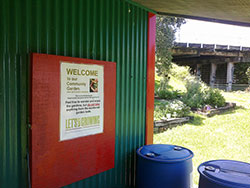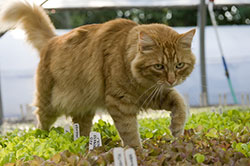by M. Bunning and M. Newby 1(3/2010)
Quick Facts…
- Community gardens offer unique opportunities to enjoy the rewards of growing your own food.
- To ensure safety and quality, community gardeners should manage gardens and handle fresh produce properly.
- Following these practical tips can help you enjoy safe garden grown fruits and vegetables.
 |
Microorganisms can be difficult to remove by washing – the most effective way to ensure the safety of fruits and vegetables is through the prevention of contamination. To promote safety from the garden to the table, gardeners can follow these recommended steps when gardening, transporting, serving, preparing, and preserving fresh fruits and vegetables.
At the Garden
Water. Use potable water (equal in quality to tap water) in community gardens and when rinsing fresh produce following harvest. If well water is used, regular maintenance should be performed to prevent contamination of the water from surface runoff or soil penetration. Test well water every one to two years and more frequently when the well is in poor condition. Irrigation practices such as soaker hoses or drip irrigation, which minimize contact between the water and edible parts of plants, reduce the potential for contamination.
Soil Amendments. Manure and other materials must be composted to proper temperatures to kill harmful bacteria. Disease-causing bacteria may survive in uncomposted (raw) manure up to a year or longer. Thoroughly wash tools and gloves that have been in contact with manure before using in the garden area. Composting plant materials alone (without manure) will help avoid potential problems with bacteria that cause human disease.
Soil and Plant Treatments. The use of fertilizers, insecticides or weed repellents that may affect other plots is generally prohibited. Most community gardens follow organic production standards and do not allow the use of products not certified as organic.
Animals. To prevent contamination of soil and produce with fecal material, restrict garden access to pets, livestock, and wild animals.
 |
Debris. Limit vegetation surrounding garden areas. Patches of vegetation or debris can serve as gathering places for rodents and other pests. Remove decaying produce from the garden to avoid attracting flies and other insects.
Gloves. Wearing gloves when gardening is recommended; gardening gloves with nylon liners or rubber coatings offer more protection than canvas gloves. Always wash hands after working in the garden, even if gloves are worn. In addition to wearing gloves, gardeners should be up-to-date on tetanus boosters as Clostridium tetani bacteria live in the soil and enter the body through breaks in the skin. To reduce risk of exposure to Toxoplasma gondii, potentially harmful parasites associated with cat feces, pregnant women should always wear gloves when gardening.
On the Way Home
Harvest Totes. All equipment used in harvesting such as bins, totes, gloves, buckets, and baskets should be made with food grade materials and cleaned routinely with soap and water to prevent microbial contamination.
Transport. Heat can take a toll on freshly harvested greens and other types of produce, causing a decrease in nutrients, quality and safety. Bring a cooler with ice packs for transporting fresh produce home, particularly if you have other stops to make along the way.
At Home
Storage. Most fruits and vegetables store best in the refrigerator at 35 to 40F. Tomatoes and melons can be stored at room temperature until ripe or cut, and then refrigerated. It is recommended not to wash produce before storing. Washed produce may deteriorate faster during storage, especially soft fruits such as strawberries. Before storing produce, separate and discard spoiled fruits or vegetables to prevent the spread of spoilage organisms.
Preparation. Always wash fresh fruits and vegetables just before use. Under running water, rub fruits and vegetables briskly with your hands to remove dirt, insects, and surface microorganisms. If immersing in water, a clean bowl is a better choice than the sink. Produce with a hard rind or firm skin may be scrubbed with a vegetable brush. Fruits and vegetables should not be washed with detergent or bleach solutions. Many types of fresh produce are porous and could absorb these chemicals, changing their safety and taste. If you plan to sell or share fresh produce that has been grown in the community garden, let users know that it needs to be washed thoroughly before consuming.
Preservation. Fresh garden produce can be preserved by freezing, canning or drying. Fruits, tomatoes and pickled vegetables may be canned in a boiling water bath using USDA recommended processing times. *To adjust boiling water bath times for altitude, add 1 minute for each 1,000 feet above sea level if the time is 20 minutes or less. If the processing time is more than 20 minutes, increase by 2 minutes per 1,000 feet. Tomatoes should be acidified to ensure safety by adding 1 tablespoon of bottled lemon juice or ¼ teaspoon citric acid per pint.
Vegetables (low-acid foods) must be canned in a steam pressure canner at 240F for the appropriate time to destroy heat-resistant bacteria. *When using steam pressure canners at altitude, increase the processing pressure by ½-pound per 1,000 feet above sea level (12.5 pounds for 5,000 feet; 13.5 pounds for 7,000 feet; 15 pounds for 10,000 feet) if using dial gauges. If using a weighted gauge, use the 15-pound weight between 1,000 and 10,000 feet elevation.
Resources
CDC 2009. Garden Health and Safety Tips. Centers for Disease Control and Prevention, https://www.atsdr.cdc.gov/soilshop/soil-gardening-health.html
Colorado Farm Fresh. 2009. Safe Food Facts for Farmers’ Markets by P. Kendall, www.coloradoproud.org.
Islam, M., M. Doyle, S. Phatak, P. Millner, and X. Jiang. 2005. Survival of Escherichia coli O157:H7 in soil and on carrots and onions grown in fields treated with contaminated manure composts or irrigation water. Food Micro. 22:63-70.
*The followlng fact sheets or publications are available at www.extension.colostate.edu
- 9.314 Making Pickled Peppers
- 6.703 Bacteria in Water Wells
- 8.704 Cost of Preserving and Storing Food
- 9.302 Food Preservation Without Sugar or Salt
- 9.303 Making Jellies
- 9.304 Making Pickles
- 9.308 Drying Vegetables
- 9.309 Drying Fruits
- 9.311 Leathers and Jerkies
- 9.330 Freezing Vegetables
- 9.331 Freezing Fruits
- 9.341 Canning Tomatoes and Tomato Products
- 9.347 Canning Fruits
- 9.348 Canning Vegetables
- 9.369 Preventing E. coli from Garden to Plate
- 9.373 Health Benefits and Safe Handling of Salad Greens
1M. Bunning, Department of Food Science and Human Nutrition, Extension food safety specialist and assistant professor; M. Newby, CSU student, 3/2010.
Colorado State University, U.S. Department of Agriculture, and Colorado counties cooperating. CSU Extension programs are available to all without discrimination. No endorsement of products mentioned is intended nor is criticism implied of products not mentioned.





